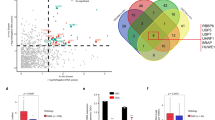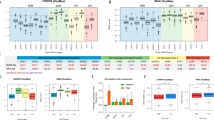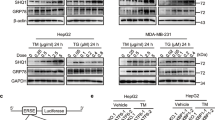Abstract
CSR1 (cellular stress response 1), a newly characterized tumor-suppressor gene, undergoes hypermethylation in over 30% of prostate cancers. Re-expression of CSR1 inhibits cell growth and induces cell death, but the mechanism by which CSR1 suppresses tumor growth is not clear. In this study, we screened a prostate cDNA library using a yeast two-hybrid system and found that the cleavage and polyadenylation-specific factor 3 (CPSF3), an essential component for converting heteronuclear RNA to mRNA, binds with high affinity to the CSR1 C terminus. Further analyses determined that the binding motifs for CPSF3 are located between amino acids 440 and 543. The interaction between CSR1 and CPSF3 induced CPSF3 translocation from the nucleus to the cytoplasm, resulting in inhibition of polyadenylation both in vitro and in vivo. Downregulation of CPSF3 using small interfering RNA induced cell death in a manner similar to CSR1 expression. A CSR1 mutant unable to bind to CPSF3 did not alter CPSF3 subcellular distribution, did not inhibit its polyadenylation activity and did not induce cell death. In summary, CSR1 appears to induce cell death through a novel mechanism by hijacking a critical RNA processing enzyme.
This is a preview of subscription content, access via your institution
Access options
Subscribe to this journal
Receive 50 print issues and online access
$259.00 per year
only $5.18 per issue
Buy this article
- Purchase on Springer Link
- Instant access to full article PDF
Prices may be subject to local taxes which are calculated during checkout






Similar content being viewed by others
References
Coon SW, Savera AT, Zarbo RJ, Benninger MS, Chase GA, Rybicki BA et al. (2004). Prognostic implications of loss of heterozygosity at 8p21 and 9p21 in head and neck squamous cell carcinoma. Int J Cancer 111: 206–212.
Dominski Z, Yang XC, Marzluff WF . (2005a). The polyadenylation factor cpsf-73 is involved in histone-pre-mrna processing. Cell 123: 37–48.
Dominski Z, Yang XC, Purdy M, Wagner EJ, Marzluff WF . (2005b). A cpsf-73 homologue is required for cell cycle progression but not cell growth and interacts with a protein having features of cpsf-100. Mol Cell Biol 25: 1489–1500.
Gallucci M, Merola R, Farsetti A, Orlandi G, Sentinelli S, De Carli P et al. (2006). Cytogenetic profiles as additional markers to pathological features in clinically localized prostate carcinoma. Cancer Lett 237: 76–82.
Han HJ, Tokino T, Nakamura Y . (1998). Csr, a scavenger receptor-like protein with a protective role against cellular damage caused by UV irradiation and oxidative stress. Hum Mol Genet 7: 1039–1046.
Isaacs JT . (1997). Molecular markers for prostate cancer metastasis. Developing diagnostic methods for predicting the aggressiveness of prostate cancer. Am J Pathol 150: 1511–1521.
Jemal A, Murray T, Ward E, Samuels A, Tiwari RC, Ghafoor A et al. (2005). Cancer statistics, 2005. CA Cancer J Clin 55: 10–30.
Jemal A, Siegel R, Ward E, Hao Y, Xu J, Murray T et al. (2008). Cancer statistics, 2008. CA Cancer J Clin 58: 71–96.
Jemal A, Siegel R, Ward E, Murray T, Xu J, Thun MJ . (2007). Cancer statistics, 2007. CA Cancer J Clin 57: 43–66.
Kurimoto F, Gemma A, Hosoya Y, Seike M, Takenaka K, Uematsu K et al. (2001). Unchanged frequency of loss of heterozygosity and size of the deleted region at 8p21–23 during metastasis of lung cancer. Int J Mol Med 8: 89–93.
Luo JH, Yu YP, Cieply K, Lin F, Deflavia P, Dhir R et al. (2002). Gene expression analysis of prostate cancers. Mol Carcinog 33: 25–35.
Ohata H, Emi M, Fujiwara Y, Higashino K, Nakagawa K, Futagami R et al. (1993). Deletion mapping of the short arm of chromosome 8 in non-small cell lung carcinoma. Genes Chromosomes Cancer 7: 85–88.
Ryan K, Calvo O, Manley JL . (2004). Evidence that polyadenylation factor cpsf-73 is the mrna 3′ processing endonuclease. RNA 10: 565–573.
Wijsman JH, Jonker RR, Keijzer R, van de Velde CJ, Cornelisse CJ, van Dierendonck JH . (1993). A new method to detect apoptosis in paraffin sections: In situ end-labeling of fragmented DNA. J Histochem Cytochem 41: 7–12.
Wistuba II, Behrens C, Virmani AK, Milchgrub S, Syed S, Lam S et al. (1999). Allelic losses at chromosome 8p21–23 are early and frequent events in the pathogenesis of lung cancer. Cancer Res 59: 1973–1979..
Yu G, Tseng GC, Yu YP, Gavel T, Nelson J, Wells A et al. (2006). Csr1 suppresses tumor growth and metastasis of prostate cancer. Am J Pathol 168: 597–607.
Yu YP, Landsittel D, Jing L, Nelson J, Ren B, Liu L et al. (2004). Gene expression alterations in prostate cancer predicting tumor aggression and preceding development of malignancy. J Clin Oncol 22: 2790–2799.
Yu YP, Luo JH . (2006). Myopodin-mediated suppression of prostate cancer cell migration involves interaction with zyxin. Cancer Research 66: 7414–7419.
Acknowledgements
This study was supported by grants from the National Cancer Institute to JHL (RO1 CA098249), the development fund from the Department of Urology, University of Pittsburgh and the John Rangos Foundation for Enhancement of Research in Pathology.
Author information
Authors and Affiliations
Corresponding author
Rights and permissions
About this article
Cite this article
Zhu, ZH., Yu, Y., Shi, YK. et al. CSR1 induces cell death through inactivation of CPSF3. Oncogene 28, 41–51 (2009). https://doi.org/10.1038/onc.2008.359
Received:
Revised:
Accepted:
Published:
Issue Date:
DOI: https://doi.org/10.1038/onc.2008.359
Keywords
This article is cited by
-
Comprehensive analysis of alternative polyadenylation regulators concerning CD276 and immune infiltration in bladder cancer
BMC Cancer (2022)
-
Population-level deficit of homozygosity unveils CPSF3 as an intellectual disability syndrome gene
Nature Communications (2022)
-
Alternative Polyadenylation: a new frontier in post transcriptional regulation
Biomarker Research (2020)
-
LncRNA CASC9 interacts with CPSF3 to regulate TGF-β signaling in colorectal cancer
Journal of Experimental & Clinical Cancer Research (2019)
-
Targeting genomic rearrangements in tumor cells through Cas9-mediated insertion of a suicide gene
Nature Biotechnology (2017)



